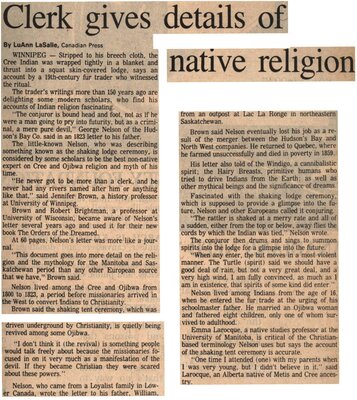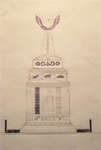"Clerk Gives Details of Native Religion"
- Full Text
- Clerk gives details of native religionBy LuAnn LaSalle, Canadian Press
WINNIPEG - Stripped to his breech cloth, the Cree Indian was wrapped tightly in a blanket and thrust into a squat skin-covered lodge, says an account by a 19th-century fur trader who witnessed the ritual.
The trader's writings more than 150 years ago are delighting some modern scholars, who find his accounts of Indian religion fascinating.
"The conjuror is bound head and foot, not as if he were a man going to pry into futurity, but as a criminal, a mere pure devil," George Nelson of the Hudson's Bay Co. said in an 1823 letter to his father.
The little-known Nelson, who was describing something known as the shaking lodge ceremony, is considered by some scholars to be the best non-native expert on Cree and Ojibwa religion and myth of his time.
"He never got to be more than a clerk, and he never had any rivers named after him or anything like that," said Jennifer Brown, a history professor at University of Winnipeg.
Brown and Robert Brightman, a professor at University of Wisconsin, became aware of Nelson's letter several years ago and used it for their new book The Orders of the Dreamed.
At 60 pages, Nelson's letter was more like a journal.
"This document goes into more detail on the religion and the mythology for the Manitoba and Saskatchewan period than any other European source that we have," Brown said.
Nelson lived among the Cree and Ojibwa from 1800 to 1823, a period before missionaries arrived in the West to convert Indians to Christianity.
Brown said the shaking tent ceremony, which was driver underground by Christianity, is quietly being revived among some Ojibwa.
"I don't think it (the revival) is something people would talk freely about because the missionaries focused in on it very much as a manifestation of the devil. If they became Christian they were scared about these powers."
Nelson, who came from a Loyalist family in Lower Canada, wrote the letter to his father, William, from an outpost at Lac La Ronge in northeastern Saskatchewan.
Brown said Nelson eventually lost his job as a result of the merger between the Hudson's Bay and North West companies. He returned to Quebec, where he farmed unsuccessfully and died in poverty in 1859.
His letter also told of the Windigo, a cannibalistic spirit; the Hairy Breasts, primitive humans who tried to drive Indians from the Earth; as well as other mythical beings and the significance of dreams.
Fascinated with the shaking lodge ceremony, which is supposed to provide a glimpse into the future, Nelson and other Europeans called it conjuring.
"The rattler is shaked at a merry rate and all of a sudden, either from the top or below, away flies the cords by which the Indian was tied," Nelson wrote.
The conjuror then drums and sings to summon spirits into the lodge for a glimpse into the future.
"When any enter, the hut moves in a most violent manner. The Turtle (spirit) said we should have a good deal of rain, but not a very great deal, and a very high wind. I am fully convinced, as much as I am in existence, that spirits of some kind did enter."
Nelson lived among Indians from the age of 16, when he entered the fur trade at the urging of his schoolmaster father. He married an Ojibwa woman and fathered eight children, only one of whom survived to adulthood.
Emma Larocque, a native studies professor at the University of Manitoba, is critical of the Christian-based terminology Nelson uses but says the account of the shaking tent ceremony is accurate.
"One time I attended (one) with my parents when I was very young, but I didn't believe in it," said Larocque, an Alberta native of Metis and Cree ancestry.
- Mystery Question
- When was this article published?[Please answer by clicking on the Comments tab]
- Creator
- LaSalle, LuAnn, Author
- Media Type
- Newspaper
- Item Types
- Articles
- Clippings
- Description
- "Stripped to his breech cloth, the Cree Indian was wrapped tightly in a blanket and thrust into a squat skin-covered lodge, says an account by a 19th-century fur trader who witness the ritual."
- Subject(s)
- Personal Name(s)
- Nelson, George ; Brown, Jennifer ; Brightman, Robert ; Nelson, William ; Larocque, Emma.
- Corporate Name(s)
- Hudson's Bay Company ; University of Winnipeg ; University of Wisconsin ; University of Manitoba.
- Local identifier
- SNPL002631v00d
- Collection
- Scrapbook #1 by Janet Heaslip
- Language of Item
- English
- Geographic Coverage
-
-
Manitoba, Canada
Latitude: 49.8844 Longitude: -97.14704
-
- Copyright Statement
- Public domain: Copyright has expired according to Canadian law. No restrictions on use.
- Copyright Holder
- Canadian Press
- Contact
- Six Nations Public LibraryEmail:info@snpl.ca
Website:
Agency street/mail address:1679 Chiefswood Rd
PO Box 149
Ohsweken, ON N0A 1M0
519-445-2954



